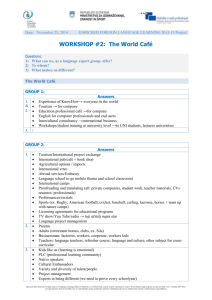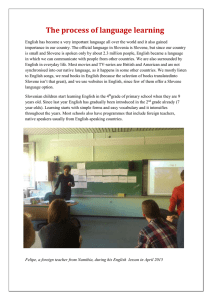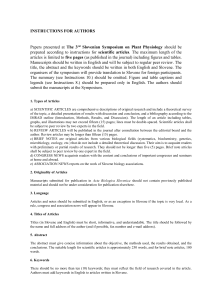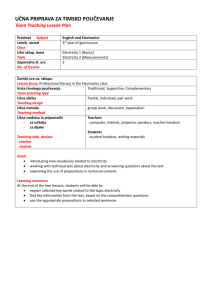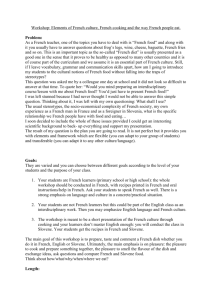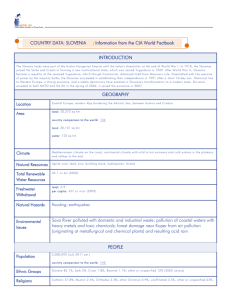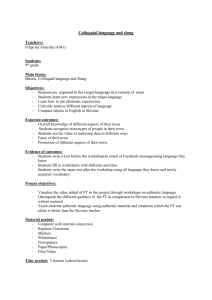Challenges of Slovene as a Medium-Sized Language Community Maja Bitenc
advertisement
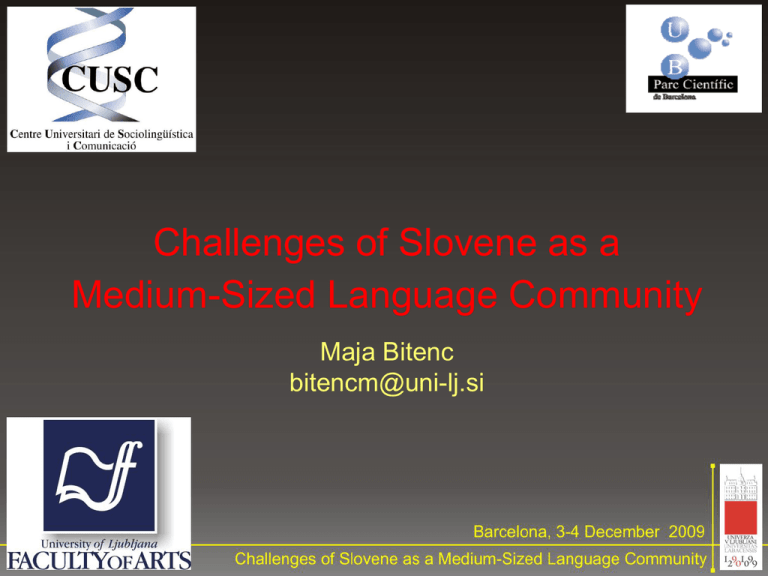
Challenges of Slovene as a Medium-Sized Language Community Maja Bitenc bitencm@uni-lj.si December 3 – Anniversaries France Prešeren’s, the greatest Slovene poet’s, birthday (born 1800) 90th birthday of Slovene university – University of Ljubljana Fran Ramovš – first lecture on historic grammar of Slovene Geographical Position of Slovenia Language Status 1991: Slovenia becomes independent Slovene – official language of the Republic of Slovenia national language in all areas of public life Constitution of Slovenia, Article 11: “The official language in Slovenia is Slovene. In those municipalities where Italian or Hungarian national communities reside, Italian or Hungarian shall also be official languages.” 2004: Slovenia joins the European Union Slovene – one of the 23 official languages of the European Union Slovene – South Slavic Language Around 2,4 million speakers Official language Regional or local official language Slovenes also in European countries Germany, France, Sweden, Switzerland ex-Yugoslavia Croatia, BiH, Serbia, Montenegro, Macedonia overseas USA, Canada, Argentina, Australia Demographic Data 2002 national census: 1 964 036 people in Slovenia, Slovene mother tongue: 1 723 434 (87 %) Slovene nationality: 1 631 363 the number of people with Slovene mother tongue – incerasing, but slower than the population the percentage of people with Slovene mother tongue – decreasing Population of Slovenia by Mother Tongue (2002) 87 % Slovene (1 723 434) 7,9 % »Serbo-Croatian« (153 172): Croatian 2,8 %, 1,9 Serbo-Croatian %, Serbian 1,6 %, Bosnian 1,6 % 0,4 % Albanian (7177) 0,4 % Hungarian (7713) 0,2 % Italian (3762) 0,2 % Macedonian (4760) 0,2 % Romany (3834) 0,1 % German (1628) Language(s) of Communication At Home (2002) In Public (1991) 91,1 % Slovene 3,3 % Slovene and »Serbo-Croatian« 1 % »Serbo-Croatian« 0,2 % Hungarian 0,2 % Slovene and Italian 0,2 % Slovene and Hungarian 0,1 % Italian 0,1 % Romany 0,1 % Albanian 94,4 % Slovene 1,1 % Slovene and »Serbo-Croatian« 0,9 % »Serbo-Croatian« 0,3 % Slovene and Italian 0,2 % Slovene and Hungarian A Glimpse into the Past The oldest Slovene written text? Freising Manuscripts, around 1000 The first book in Slovene? Primož Trubar: Catechism and Spelling Book, 1550 The first translation of the Bible? Jurij Dalmatin, 1584 The first Slovene Grammar? Adam Bohorič, 1584 A Glimpse into the Past endeavours for Slovene in all domains of public life in the middle of the 19th century connected with the national movement, language as an element of national cohesion under Austro-Hungarian monarchy Slovene gradually introduced into educational system as a lanugage of instruction 1918 – the first Yugoslav state: »Serbo-Croatian-Slovene« language in the Constitution 1945–1991 Yugoslavia – formally: languages have equal rights 1991: Slovene as the official language Ideologies/Attitudes concerning Slovene Classical controversy traditional approach defending position language – value in itself foreign languages – a threat more liberal approach diminished symbolic function of language functional value of language(s) Sociolinguistic Changes since 1991 language status new domains different status and prestige of languages of former Yugoslavia increasing number of foreigners in Slovenia (refugees, immigrants) increasing number of speakers of Slovene as a second/foreign language Sociolinguistic Changes since 2004 language status globalisation, free flow of people and labour – reflected also in a socio-cultural and communication sphere Slovenia – attractive as a EU country becoming more diverse communication technology English language words and patterens warnings concerning increasing use of English Sociolinguistic Changes since 2004 additional value of knowledge of Slovene because of its status more speakers of Slovene as a second/foreign language Slovene at universities abroad Slovene lectureship at 54 universities around the world broadening and enlarging the network of Slovene lanugage teaching opportunities translation into Slovene and from Slovene widespread multilingualism in Slovenia Language Policy first years after 1991 – less active language policy 1994–2004: the first institutionalized frame of language policy activity: a permanent working body for language policy and language planning at the parliamentary committee for culture, education and sport 2000–2004: Committee for the Slovene Language 2004– Sector for the Slovene language at the Ministry of Culture 2004: Public Use of the Slovene Language Act - long, controversial discussion about the drafts - ideological construct of pure Slovene language as a value in itself Language Policy Resolution on National Programme for Language Policy 2007-2011 the first integral document about language policy in the history of Slovene lanugage community strategic guidelines in different domains of language policy activities 12 main goals, 113 items principal guideline: the importance and role of Slovene as the national lanugage, developing language competence and raising language awareness no profound analysis of the situation ! 250.375 € intended for attempts with sinhronisation of films 104.323 € for general and specialised reference books for Slovene Infrastructure of Slovene Slovene orthography and grammar sanctioned by the Orthographic Commission and the Fran Ramovš Institute of Slovenian Language, both part of the Slovenian Academy of Sciences and Arts - Slovene Orthography, 2001 - Dictionary of Standard Slovene, 1-5, 1970-1991, single volume 1994, available online - Slovenian Grammar, 1976, 1984, 1991, 2000 serious deficiencies Infrastructure of Slovene shortage of contemporary, user-friendly reference books strong tradition of language revision/proof-reading the responsibility of the author vs. proffesional language reviser? speakers – not self-confident, not independent language consultancies, newspaper columns e-consultancies democratic consultancies Corpora Monolingual FIDA plus – 600 million words, referential corpus of Slovene (Faculty of Arts and Faculty of Social Sciences of the University of Ljubljana, Jožef Stefan Institute) Nova beseda – 240 milion words (Fran Ramovš Institute of Slovenian Language) Bilingual Evrokorpus – 222 million words, Slovene parallel corpus (Translation Unit of the Slovenian Government Office for European Affairs, the Secretariat-General of the Government of the Republic of Slovenia) “Communication in Slovene” Project – an Example of Good Practice June 2008 – December 2013 Activities: Spoken Corpus of Slovene – 1 million words Written Corpus of Slovene – 1 billion words Corpus Interface for Pedagogical Purposes Training Corpus Lexicon of Inflected Forms Slovene Lexical Database New Didactics of Slovene Language Teaching Pedagogical Corpus-based Grammar Manual of Style Foreign Languages in Slovenia a lot of experiences with multilingualism and plurilingualism foreign lanugages – popular economic interests, size of the country, national multilingualism with Hungarian and Italian, historical lanugage ties the question of foreign lanugages is stressed afer 2004 in primary education: in 2011/2012 - 1st foreign lanugage in the first grade of primary school - compulsory 2nd foreign language in the last three years of primary school (at the moment: 2nd foreign lanugage as an optional subject in the last three years: English, French, Spanish, Russian, Latin, German, Italian, Croatian, Serbian and Macedonian) Foreign Languages in Slovenia Ability to communicate in Serbo-Croatian (59 %), English (57 %), German (50 %) Most useful langages: English (78 %), German (61 %), Italian (12 %) French (4 %), Spanish (2 %), Russian (1 %) Use of foreign languages (2009, N=700) in business communication 65 % no 25 % English 15 % German 13 % languages of former Yugoslavia private sphere 32 % no 34 % languages of former Yugoslavia 32 % English 25 % German 22 % Italian Case Study 1: Slovene in Science and Higher Education discussions about language in this domain – often polarized Legislation Higher Education Act (Article 8) – protects Slovene as the language of instruction in higer education the following may be provided in a foreign language: - foreign-language study programmes - parts of study programmes, if visiting teachers participate in the provision thereof or if significant numbers of foreign students are enrolled therein - study programmes if they are also provided in Slovene Slovene in Science and Higher Education Strategy of the University of Ljubljana ( Bologna declaration and Frame of economic and social reforms for bigger prosperity in Slovenia): 10 % foreign students 10 % programmes carried out by foreign professors Problematic increasing use of English in certain classes of certain study programmes textbooks, scientific newspapers, terminology – deficiencies Slovene scientific achievements only get half of all available points according to the proposal of the document entitled Measures for the election in the title of university teachers, scientific workers and university co-workers Slovene in Science and Higher Education Resolution on National Programme for Language Policy 2007-2011 Goal 10: For the consolidation of Slovene in higher education and science - university subject »professional-scientific variety of standard Slovene« - university textbooks in Slovene - promotion of publishing scientific papers in Slovene and using Slovene at international conferences in Slovenia - parallel study programmes in English and Slovene – but no financial support! finding appropriate balance between local and global Conclusion Optimistic ☺ Slovene – the strongest status ever the number of people with Slovene mother tongue – increasing Slovene as a second/foreign language production in Slovene translation into Slovene and from Slovene Conclusion Challenges infrastucture of Slovene (user-friendly reference books, dictionaries) reducing defensive discurses and ideologies proactive language policy searching answers to questions of living in a multicultural and multlingual community opportunities for learning Slovene integration of immigrants appropriate balance between Slovene and English in scientific discourse Slovene language revitalisation among Slovene minorities and Slovenes around the world vitality of language and self-confident speakers Thank you for your attention! Maja Bitenc bitencm@uni-lj.si
